
Vigil at the National Congress of Argentina, December 29, 2020. Photo by the author, used with permission.
I’ve held feminist views since childhood, long before I was able to call them feminist. My greatest lessons in learning and awareness, however, arrived much more recently. The year 2018 was the point at which I could no longer be a mere political spectator and felt propelled to participate in collective activism, spurred by the first-ever debate by Argentina’s Senate on a bill in support of legal voluntary abortion [1].
Early on the morning of December 30, 2020, I woke up in near disbelief to historic news: The Senate approved [2] The Voluntary Interruption of Pregnancy Law [3].
That previous evening, I had stood waiting amid throngs in the streets. We were collectively straining against our many anxieties, including uncertainty at not knowing a few key senators’ positions, fears of the bill’s possible rejection, and brimming emotions for everything our culminating efforts had achieved from the last few years up to this point. I regretted leaving before the results were in, but awoke thrilled to see the reactions of those who remained at the vigil until 5 in the morning, when the decision was finally made.
? El momento del resultado. Escuchen eso, piel de gallina.#ESLEY [4] pic.twitter.com/sbeLD1PSqY [5]
— Sole (@ssoledad1983_) December 30, 2020 [6]
? The moment the results came in. Listen to that, goosebumps.#ESLEY [4] [#ITSLAW] pic.twitter.com/sbeLD1PSqY [5]
— Sole (@ssoledad1983_) December 30, 2020 [6]
For nearly all of 2020, the COVID-19 pandemic [7] impeded mass gatherings and led activists to adopt virtual platforms. Once the strictest measures were lifted, however, social activism took to the streets again.
On November 16, 2020, after facing mounting pressure [8] from feminist organizations, Argentine President Alberto Fernández at last fulfilled a promise [9] he had made in early March [10] to present a bill before Congress [11] to legalize voluntary abortion (an act that had stalled as the nation underwent COVID-19 emergency measures [12]).
Briefings [13]began under a tight schedule on December 1 in the Lower House, and the historic result was achieved on the early morning of the 30th.
On key dates, the National Campaign for the Right to Legal, Safe and Free Abortion [14] organized live social media reportage [15], rallies, and vigils [16] at the National Congress and across every city in Argentina to show support for the bill and demand representatives cast a vote in favor of the right to decide. Attendees were urged to take caution [17] with masks and hand sanitizers, and to avoid crowds, hugs, and close contact as much as possible.
¡En todo el país!??
Sumate a hacer historia, en las calles por nuestros derechos.
Pasá la voz. #AbortoLegal2020 [18] pic.twitter.com/DC6RPxj6HF [19]— #AbortoLegal2020 ? (@CampAbortoLegal) December 9, 2020 [20]
In every country!??
Join us to make history, in the streets for our rights.
Spread the word. #AbortoLegal2020 [18] pic.twitter.com/DC6RPxj6HF [19]— #AbortoLegal2020 ? (@CampAbortoLegal) December 9, 2020 [20]
Almost a year had gone without in-person contact, and many of us yearned to see one another without the means of a computer screen. We enlisted several friends from the group Traductoras e Intérpretes Feministas [21] (Feminist Translators and Interpreters, or TEIFEM [22]) to make our physical presence at these events visible. There are no words that could explain what this meant to us.

Vigil at the National Congress of Argentina, December 29, 2020. Photo by the author, used with permission.
In Buenos Aires, Argentina’s capital, mass demonstrations during the debates occupied the entire 400-meter (1,300-foot) length of the Congressional Plaza [23] along both Rivadavia Avenue and Callao Avenue from the corner of the National Congress. On the opposite end of the square, separated by extensive security fencing, pro-life protesters gathered to express their opposition to the law.
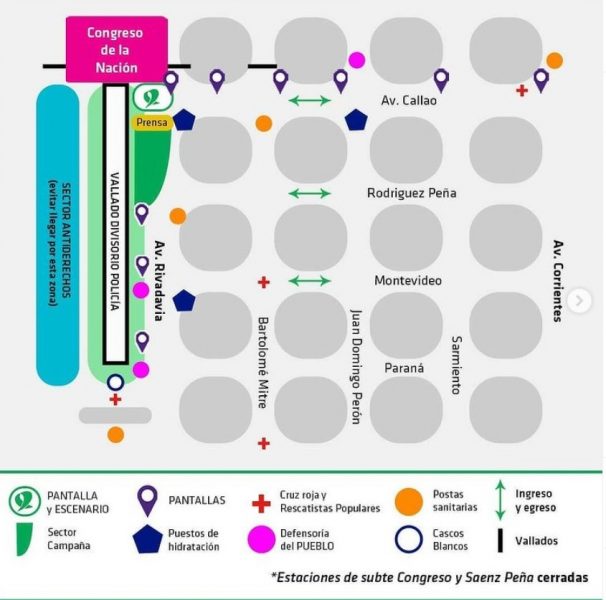
Map of the National Congress surroundings where vigils took place, posted on Instagram by @CampAbortoLegal [24].
Organizing efforts [25] were flawless, with extensive security operations, CEPA [26](the Evacuation and First Aid Corps) and Red Cross teams, and hydration stations assembled, along with attendants who offered free sanitizers and disinfectant to attendees. A center stage, speakers, and a large screen were positioned on every block to broadcast the debates live.
Crowds were unavoidable, but nearly all wore a mask, and every effort was made to follow sanitary measures.
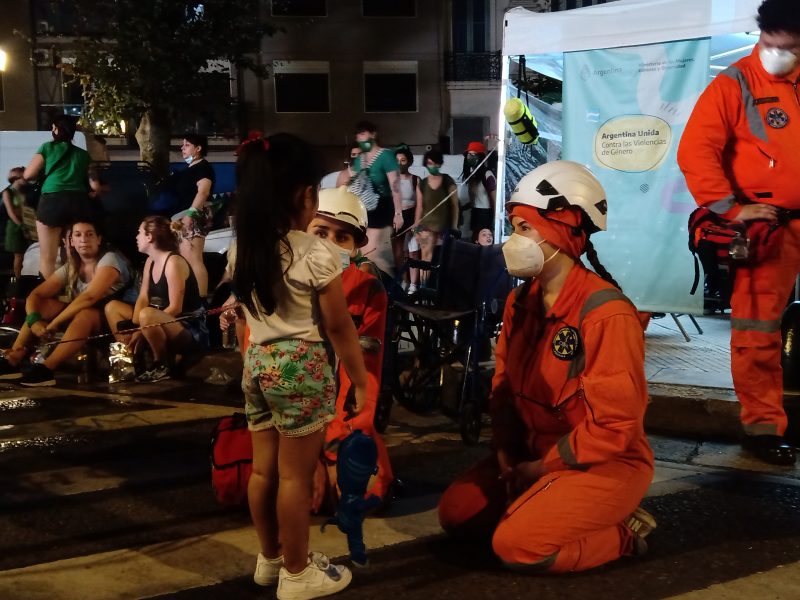
CEPA [26]volunteers talk with a girl at the vigil on December 29, 2020. Photo by the author, used with permission.
A festive and colorful atmosphere flourished on the “green side” of the fence, with a sea of hopeful smiles buffered against the fear of history repeating itself like in 2018, when the Senate had rejected the bill [27] by a difference of seven votes. Perhaps what attendees were celebrating was that, in spite of past failures, the first debate had firmly put the issue on the table [28], settled into society [29], and begun to stir up family conversations.
At that point, there was no turning back.
Around the National Congress, each “green” demonstration seemed more like a large fair, with green- and purple-bedecked bands, batucadas [30], techno music, banners and posters, accessories, T-shirts, glitter, make-up, sparklers, and dancing.
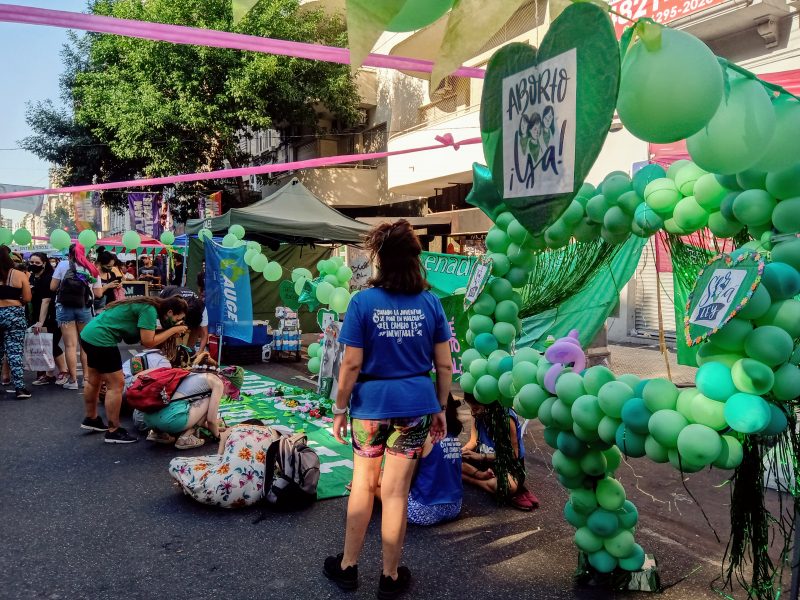
Vigil at the National Congress, December 29, 2020. Photo by the author, used with permission.
Organizations passed out information and sold stickers, postcards, and accessories in fundraising efforts. Numerous political groups, unions, NGOs, and social movements made their presence visible and promoted causes like the separation of Church and State [31], comprehensive sexual education [32], LGTBQ+ rights, abortion clinic lifeguards [33] to ensure safe passageway for patients, and more.
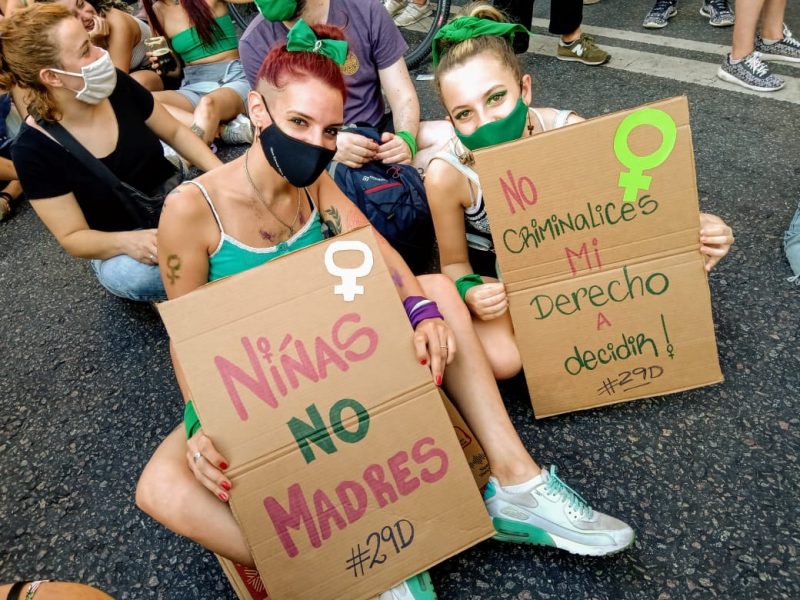
Vigil at the National Congress, December 29, 2020. Photo by the author, used with permission.
Teenagers played soccer on makeshift fields erected by the Coordinadora de Fútbol Feminista [34] (Feminist Soccer Coordinators). At the center stage, organizations took turns explaining basic tenets of the bill and their reasons for supporting it.
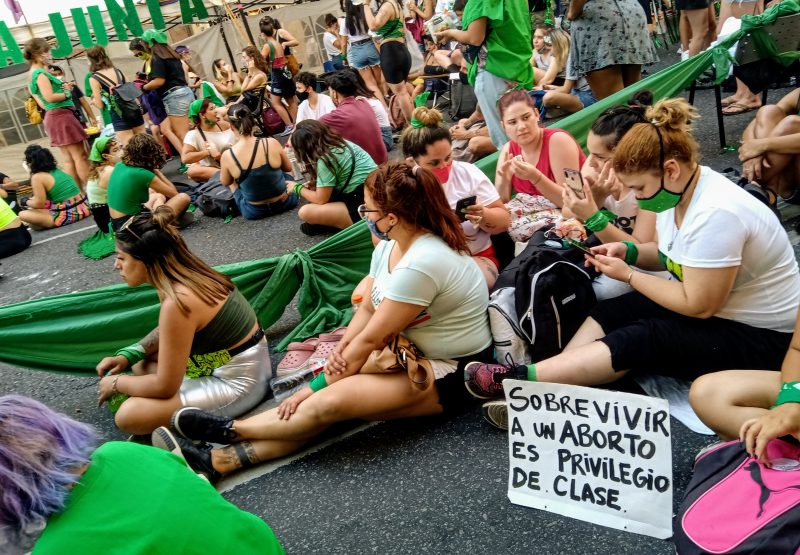
Vigil at the National Congress, December 29, 2020. Photo by the author, used with permission.
In other areas, families danced and took photos, people painted faces, and circles of batucadas sang feminist catchphrases.

Percussionists at the vigil on December 29, 2020. Photo by the author, used with permission.
Despite the wide range of personal, partisan, and political positions, there was a prevailing sense of unity, joy and companionship that remained steadfast in facing a common cause that affects all ages, race, political positions, and social classes.
Now is not the time for feminism to grow complacent. We will continue the fight to ensure compliance with the law and dismantle attempts to obstruct it. But for now, we’ve taken a few days to celebrate this historic achievement borne from a decades-long struggle.